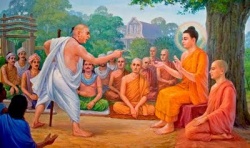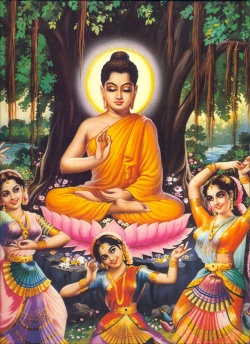Avanti
Avanti
阿槃提国 (Skt, Pali; Jpn Ahandai-koku)
An ancient kingdom of west-central India.
In Shakyamuni Buddha's time, Avanti was one of the sixteen great states, and Ujjayiniwas its capital.
From the time of King Pradyota in the sixth century B.C.E., Avanti prospered as a powerful kingdom and rival to the kingdom of Magadha.
King Pradyota was a contemporary of Bimbisara, the king of Magadha, and his son Ajatashatru. Mahakatyayana, one of Shakyamuni Buddha's ten major disciples, was a native of Avanti.
According to one account, Utpalavarna, a nun in Shakyamuni's Order, was also a native of Avanti.
Avanti (Sanskrit: अवन्ति) was an ancient Indian janapada (realm), roughly corresponded to the present day Malwa region.
According to the Buddhist text, the Anguttara Nikaya, Avanti was one of the solasa mahajanapadas (sixteen great realms) of the 6th century BCE.
The janapada was divided into two parts by the Vindhyas, the northern part had its capital at Ujjayini and the southern part had its centre at Mahishmati.
The Avantis, the ancient people belonging to this realm were described as mahavala (very powerful) in the Udyoga Parva (19.24) of the Mahabharata.
According to the Vishnu Purana (II.3), the Bhagavata Purana (XII.I.36) and the Brahma Purana (XIX.17), the Avantis were associated with the Malavas, the Saurashtras, the Abhiras, the Suras, the Karushas and the Arbudas and were described as dwelling along the Pariyatra (or Paripatra) mountains (a western branch of the Vindhyas).
- The Haihayas of Mahishmati
According to the Puranic accounts, the Haihayas were the earliest rulers of Avanti, who captured the region from the Nagas.
Initially, they ruled from Mahishmati.
Later the whole janapada was divided into two parts with the capitals at Mahishmati and Ujjayini.
The Haihayas were a confederation of five clans, the Vitihotras, the Bhojas, the Avantis, the Tundikeras and the Sharyatas.
Later, the Haihayas were better known by their dominant clan - the Vitihotras.
Ripunjaya, the last Vitihotra ruler of Ujjayini was overthrown by his amatya (minister) Pulika, who placed his son, Pradyota on the throne.
The Mahagovindasuttanta of the Dighanikaya mentions about an Avanti king Vessabhu (Vishvabhu) and his capital Mahissati (Mahishmati).
Probably he was a Vitihotra ruler.
Pradyota was contemporary to Gautama Buddha.
He was also known as Chandapradyota Mahasena. Pradyota captured the Vatsa king Udayana but later he married Pradyota’s daughter Vasavadatta.
The Mahavagga described him as cruel and according to the Majjhima Nikaya, Ajatashatru, the king of Magadha fortified Rajagriha to protect it from an invasion led by Pradyota.
He also waged war on Pushkarasarin, king of Takshashila Pradyota’s chief queen Gopalamata (mother of prince
Gopala) was a disciple of Buddhist monk Mahakatyayana and constructed a stupa in Ujjayini.
Prodyota had two sons, Gopala and Palaka.
He was succeeded by Palaka.
According to Jaina accounts Palaka ascended to the throne on the day of passing away of Mahavira.
According to the Kathasaritsagara and the Avashyaka Kathanaka, the kingdom of Vatsa was already a part of Avanti during the reign of Palaka and a prince of the royal family was the governor of Kaushambi.
In the Mricchakatika, Palaka was described as a tyrant who was overthrown by a popular revolt.
This revolt placed Aryaka on the throne of Ujjayini.
The Puranas place Nadivardhana or Vartivardhana after Aryaka.
But these names are probably corruptions of Avantivardhana, the name of the son of Palaka according to the Kathasaritsagara or the son of Gopala according to the Nepali Brihatkatha.
He was defeated by Shishunaga, the king of Magadha.
Avanti was a part of the Magadha empire during the rule of the Shaishunaga and the Nanda dynasties.
During the Mauryan dynasty rule, Avanti became the Avantirāṭṭha or the western province of the empire, with its capital at Ujjayini.
The Junagarh Rock inscription of Rudradaman I (150 CE) mentions Pushyagupta as the governor of the western province during the reign of Chandragupta Maurya.
During the reign of the next ruler Bindusara, prince Ashoka was the provincial governor.
After the fall of the Mauryas, at the time of Pusyamitra Sunga, his son Agnimitra was the Magadhan viceroy at Vidisha, but he ruled independent of Magadha for all practical purposes.

